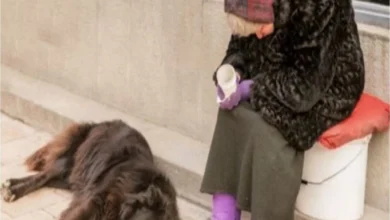Derinkuyu: Mysterious Underground City in Turkey Found in Man’s Basement

The 20,000-person Derinkuyu Underground City was discovered during a basement renovation project. It was a once-in-a-lifetime find of archaeological significance.
For perhaps thousands of years, local Cappadocians retreated underground when enemies approached. Their subterranean city was rediscovered by accident. (Credit: Yasir999, CC BY-SA 4.0)
A subterranean city was discovered in 1963 by a guy who tore down a wall in his basement.
The ancient, 280-foot-deep, up to 18-story subterranean city is up to 4,000 years old.
20,000 people could live in the Derinkuyu Underground City, the biggest of its kind.
A hot air balloon emblazoned with the Turkish flag sailed past some fairy chimneys, a rock formation typical for Cappadocia in central Turkey and one of its main tourist attractions. Another is its ancient underground cities, of which Derinkuyu is the largest. (Credit: Murat Asil / Anadolu Agency / Getty Images)
Unknown worlds are right next door to us. The barriers that divide us can be substantial and impenetrable at different times. When a Raquel Welch picture is all that separates a jail cell from the tunnel to freedom, a wardrobe transforms into a portal to Narnia, and a rabbit hole opens up to Wonderland.
An unfortunate hammer swing
All of those instances are made up. However, an actual breach of that barrier occurred in 1963. A man in Derinkuyu, Turkey, got more home improvement than he anticipated when he used a sledgehammer on a wall in his basement. He located a tunnel hidden behind the wall. And from there, more tunnels emerged, eventually linking many rooms and hallways. It was a sizable underground structure that had been abandoned by its residents and was unknown until that momentous hammer swing.
The unnamed Turk, who discovered a gigantic underground metropolis up to 18 floors and 280 feet (76 meters) deep and big enough to shelter 20,000 people, is not mentioned in the story. Who designed it and why? When and by whom was it abandoned? Some solutions are offered by history and geology.
Cappadocia Geology is incredibly rocky.
Derinkuyu lies in the province of Cappadocia, which is in the center of Turkey and is known for its fantastically craggy topography and so-called fairy chimneys. That tuff-type of rock has been eroded to create such tall stone structures. Despite its name, that stone is not particularly hard despite being made out of volcanic ash and covering much of the area.
Well-lit interior view of the otherwise dark and gloomy underground city of Derinkuyu. (Credit: Nevit Dilmen / Wikimedia Commons, CC BY-SA 3.0)
For millennia, the inhabitants have carved their own holes in the soft stone for underground residences, storage spaces, temples, and hiding places, taking cues from the wind and rain. Hundreds of underground homes may be found in Cappadocia, with 40 of them having at least two floors. None are as well-known or as big as Derinkuyu.
Early Christians, Hittites, or Phrygians?
Regarding the beginnings of Derinkuyu, the historical record is not entirely conclusive. According to some researchers, the oldest portion of the complex may have been excavated around 2000 BC by the Hittites, who ruled the area then, or else around 700 BC by the Phrygians. Others assert that local Christians established the city throughout the early century AD.
The soft rock makes tunneling relatively simple, but cave-ins are a significant risk, so whoever they were, they had remarkable competence. Thus, there is a requirement for substantial support pillars. There has never been any floor collapses at Derinkuyu.
Two aspects of the underground complex are more certain. First, the primary goal of the enormous undertaking must have been to conceal oneself from opposing troops, as evidenced by the rolling stones used to shut the city from the inside. Second, from the sixth to the tenth centuries AD, the complex underwent its final expansions and modifications, which are essentially Christian.
Getting into trouble in the dungeon
More than 15,000 shafts, the majority of which were roughly 10 cm broad and extended into the city’s first and second levels, provided ventilation for the metropolis. At the same time, it was cut off from the world above. As a result, the eighth level had adequate ventilation.
As the most ventilated, the upper levels were used as living and sleeping areas, which makes sense. A dungeon was located on the lowest levels, primarily used for storage.
A wine press, domestic animals, a monastery, and small churches could all be found in the spaces in between that were utilized for various reasons. The seventh-level cruciform church is the most well-known.
If cisterns could talk
Some shafts doubled as wells and went much deeper. The local Turkish inhabitants of Derinkuyu utilized these to obtain their water even while the underground city remained undiscovered, unaware of the secret world their buckets traversed. In case you were wondering, derin kuru is Turkish, meaning “deep well.”
The subterranean city could house up to 20,000 people, plenty of domestic animals, and enough supplies to wait out an invading army. (Credit: Yasir999, CC BY-SA 4.0)
According to a different notion, the underground city provided a comfortable haven from the region’s severe seasons. The winters and summers in Cappadocia may both get very cold and very hot. The temperature is mild and consistent underground. Furthermore, storing and protecting harvest yields from dampness and robbers is simpler.
Regardless of the importance of its other purposes, the underground city was heavily utilized as a haven for the local population during the Byzantine and Arab Wars, which lasted from the late 8th to the late 12th centuries, the Mongol Raids in the 14th century, and after the Ottoman Turks had conquered the area.
Away from the “soft” place
The local Greek populace still instinctively sought refuge in the underground city when news of massacres elsewhere reached them, according to a visiting Cambridge linguist who visited the area in the early 20th century.
To racialize their people after the Greco-Turkish War (1919–22), the two nations decided to exchange minorities in 1923. The Derinkuyu Cappadocian Greeks also departed, taking with them the knowledge of the underground city as well as the place’s Greek name, Mo (Malakopia), which means “soft” and may be an allusion to the malleability of the local stone.
Derinkuyu is currently one of Cappadocia’s most popular tourist destinations. Therefore, it is no longer considered an uncharted world. However, one might be on the opposite side of your basement wall. What about that sledgehammer? Where did you put it?








